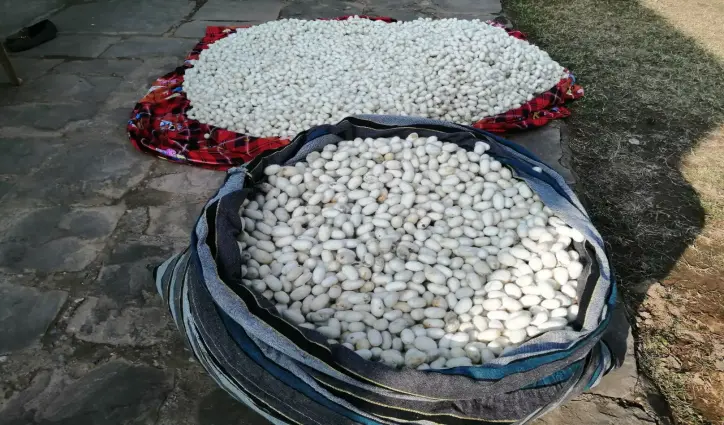Jammu and Kashmir is one of the world’s silk cocoon and yarn producing union territory. Sericulture is an agro-cottage, forest-based and labour-intensive industry in J&K that contributes significantly to economic development and sustainable livelihood.
The mulberry crop is the foundation of sericulture resource as a food plant for silkworms. It is directly responsible for creation of silk cocoons. Mulberry plant cultivation, silkworm rearing to produce silk cocoons, cocoon reeling to untwist silk filament, yarn manufacture, weaving, and silk fabric processing are all intertwined.
Sericulture in Jammu and Kashmir generates income for farm households throughout the year mainly in spring and autumn season. Farmers have been discouraged from participating in sericulture due to shrinking mulberry area, inadequate extension and support and marketing challenges, but now sericulture is experiencing a renaissance as a result of the World Bank’s assistance for the Kashmir valley in reviving the glory of the silk industry, which encourages farmers and stakeholders to participate in this sector In 2020-21 Jammu and Kashmir produced 798 metric tonnes of silk cocoons production and has seen annual compound growth rate of 2.59% which shows positive growth rate from 1990-91 to 2020-21. Sericulture is a unique end-to-end sustainable sector with minimal environmental impact when supply chain management is carefully managed.
UNESCO established the Silk Road Programme in 1989 to provide a platform for highlighting transformative impact of silk trade through the cultural interchange that occurred as traders exchanged silk from China across Asia, Europe, and Africa.
Sericulture in Jammu and Kashmir can be profitable on both local, artisanal and industrial sizes. Over millennia, sericulture has brought enormous economic benefits to local economies and has been a significant contributor to expanding trade networks and globalisation.
Today, UNESCO has designated sericulture as an Intangible Cultural Heritage. During the J&K Trade & Export Policy 2018-28, the government published a pamphlet titled â Reliving & Reviving Jammu and Kashmir Silk, which discusses the significance and promotion of the silk sector.
Sericulture generates an annual income of Rs 2027 lakh with 3.6 lakh man days in 2880 villages and 34000 households in J &K. The most prevalent method of silk fibre harvesting for the textile industry is reeling, in which the cocoon with pupae within is placed in boiling water and silk is unwound from the cocoon and rewound onto a cone or spindle like a bobbin of thread. Sericulture has the potential for a sustainable, circular economy, providing benefits to farmers and communities worldwide.
The silk industry is crucial for small and marginalised households’ sustainable livelihood. Jammu and Kashmir is an Indian bivoltine sericulture union territory with a variety of agro-climatic zones and mulberry genetic resources that are well-known around the world for producing excellent and appealing silken products.
The union territory has enormous potential to manufacture and use raw silk locally, establishing a strong backward and forward connection that can revitalise our industrial sector, enhance the sericulture industry for cocoon growers, and create sustainable growth that coordinate cocoon silk production and marketing through comprehensive effective supply chain collaborations and management.
Silk products have a ready market in Kashmir, both domestically and globally; however, the government must pay close attention to this enterprise if weavers’ socioeconomic situation is to improve. With the purpose of enhancing quality and production, the Central Silk Board developed Silk Samagra for sericulture growth in the country, including Jammu & Kashmir. It encourages Kashmiri crafts and cultural industries which promotes adventure tourism and ensures sustainable livelihood in Jammu and Kashmir.
Kashmir valley reeled silk has a shine and is well-known throughout the world because it has a longer fibre length than spun silk. All we need are ‘Growers’ to plant mulberry trees and rear Silk cocoons, which will give our industry a boost.
Kashmir is well-known for its silk carpets of outstanding quality and ingenuity are woven by silk carpet weavers and have impacted countries throughout Central Asia. Kashmiri carpets already received GI labelling, increasing global demand for these products have gained international acclaim and carved out a position for themselves due to its beauty, resilience, and longevity which ensures sustainable income.
The filatures produce basic raw material for the silk industry’s weaving segment, which is mostly sold to Rajabagh Silk Factory and Bari Brahmana silk factory. A limited fraction of it is also sold on a quota basis to private unit holders.
The government has already announced numerous small initiatives, such as free plant material and the distribution of free rearing kits, which producers use during the cocoon rearing process.
Sericulture, with its sectoral portions of production, allows sustainable growth and inclusive development of an area by providing livelihood security to many population segments specialised in cultivation, raising, reeling, and weaving. With all of the characteristics of the silk business listed above, it is acceptable to declare sericulture an excellent industry for a sustainable future.

